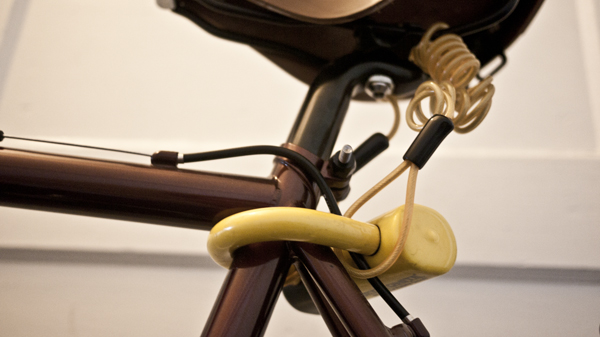(Attempting) to Secure a Brooks Saddle
Brooks saddles are like mid-90s Honda Accords–a huge target for thieves. And since I’ve already had a mid-90s Honda Accord stolen (I named it D’Accord, but didn’t have the vanity plate made in time), I intend to keep my Brooks Saddle.
Everyone has a different idea of how to best secure a saddle. It’s a little difficult to trust what anyone says about saddle safety because of a really significant sampling problem. If you have had your seat stolen, you think the way you secured it was dumb and bad. If you haven’t, you tend to think you’ve done a pretty good job of locking it up.
Here are the most common methods of securing a bike seat:
1. “Hey, that’s a funny lookin’ bolt.” The locking skewer. These fall into different categories. Some are simply bolts with unique imprints so that special tools are needed to remove them. Others claim to be more sophisticated and require that the bike be flipped over to remove them. Unfortunately, the cycling world is full of stories about how thieves have bypassed these. Vice grips and magnets seem to work just fine.
2. “You wouldn’t want it anyway.” The least sophisticated strategy on this list–just toss a plastic liquor store bag over your seat. This way thieves will have to remove a liquor store bag from your seat before stealing it. Well, they wouldn’t really have to remove the liquor store bag before stealing it. In fact, they would mostly just have a handy place to hide your seat as they leave the scene of the crime. Well, maybe they ‘ll think you have such a terrible seat that you’re ashamed of it and it’s probably not worth stealing. I don’t really understand the theory behind this, to be honest.
3. “What bike seat?” Without a doubt the most effective method of keeping your bike seat from being stolen is to take the seat off your bike. That’s right, don’t leave it outside. Just carry it with you. Hard to argue with this advice, really. The only thing ridiculous about it is that there are probably other parts of your bike equally expensive and equally easy to remove. But considering seats are the biggest target, your risk will be significantly lessened.
4. “If I can’t have you, no one will.” This is the strategy that causes the most nuisance for the actual bike owner. Take a ball bearing and superglue it into the hex imprint on the bolt. It neutralizes the effectiveness of most tools. I recommend you dial in your bike’s setup REALLY well before taking this approach. Dissolving the superglue will take a good 20 minutes with a Q-Tip as you listen to This American Life and your arm gets tired.
5. “Chains aren’t just for sprockets anymore.” I see this often in San Francisco. Riders take an old bike chain and loop it from your frame through the rails of your saddle. Chains are a pain in the ass to cut through. But if you have a chain tool handy, removing a link takes a few short moments. If you use an older rusty chain, this significantly increases the time it would take to remove a link.
6. “What I did.” I wouldn’t ever tell you that this is the best, or even a very good strategy. But considering I want to continue adjusting my bike for a little while before heading off on my bike tour, I needed something more adjustable than a ball-bearing and superglue. Luckily, I had a U-Lock for a motorcycle’s disc brakes sitting around in my apartment. Since I don’t have a motorcycle anymore, nothing’s safety was being compromised by the re-purposing effort. The lock is small enough to fit through the frame without becoming a nuisance while riding. And I’m able to take the cable and feed it through the saddle rails. How secure is this? Not very. I could see it being a secure solution with a thicker cable, but it’s heavy and kind of dumb when compared with the other options on this list.
An old hiking expression comes to mind when talking about security from bicycle theft: You don’t need to be faster than the bear, just so long as you can outrun your fellow campers. If someone is looking to make a quick theft, you’re normally going to be fine as long as your things are better secured than your neighbor’s. Unless of course the thief plans to steal lots of things at once. Or the bear is really hungry.



